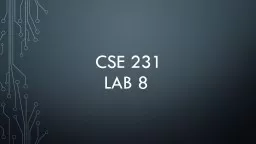

Dictionaires vs lists Creating Dictionaries Dictionaries Methods Dictionaries Visualizing Insertionordered collection of Python objects Python gt36 What is a key What is a value ID: 904536
Download The PPT/PDF document "CSE 231 Lab 8 Topics to cover" is the property of its rightful owner. Permission is granted to download and print the materials on this web site for personal, non-commercial use only, and to display it on your personal computer provided you do not modify the materials and that you retain all copyright notices contained in the materials. By downloading content from our website, you accept the terms of this agreement.
Slide1
CSE 231
Lab 8
Slide2Topics to cover
Dictionaires
vs
lists
Creating Dictionaries
Dictionaries
–
Methods
Slide3Dictionaries - Visualizing
Insertion-ordered collection of Python objects (Python >=3.6)
What is a key? What is a value?
Should be immutable
Any objects is allowed
Slide4Dictionaries vs Lists
Slide5What happens?
Given a dictionary, D, where:
D[“key”] = “value”
print(D[“key”])
“value”
Slide6Create and update a dictionary
Are dictionaries mutable?
Creating a Dictionary
M = {}
M = dict() M = { 200: "EE", 100: "ME"}Adding/updating a value in a DictionaryM[500] = "CS"
Slide7Patterns
Ints
:
x = 0 # initialize at zero
x += 1 # increment the counterStrings:s = ‘’ # initialize with empty strings += ch # concatenate characters Lists:L = [] # initialize with empty listL.append
(value) # append values to the list
Slide8Patterns
Dictionaries:
D = { } # initialize with
empty dictionary
S = “aabacdbacd” # we have a string, we want to count all the charactersfor ch in S: if
ch in D: # check to see if the key exists in the dictionary D[ch
] += 1 # increment the value if it exists else: D[ch] = 1 # set the value to 1 if it doesn’t exist
Slide9Dictionaries
–
Methods
Use this one most of the time:
.items() # Returns a set-like object of all the key-value pairs.Other options:
.keys() # Returns a set-like object of all the keys.
.values() # Returns a set-like pbject of all the values.
Slide10Additional Useful Methods & functions
D =
M.get
( 200 )
returns the value if key exists, else returns NoneE = M.pop( "Mike", None )pops (and returns) the value if the key exists, returns the second argument otherwisedel M[600]
deletes if the key exist, KeyError
if it doesn'tD = dict(L) # assuming L = [('a',1),('b',2),('c',3)]D = {'a': 1, 'b': 2, 'c': 3}
Slide11Iteration
for key, value in
M.items
(): # use most of the time
for key in M.keys():for key in M: # same as M.keys()for value in M.values():
Slide12What happens?
Given a dictionary D,
D = {“one” : 1, “two” : 2, ”three” : 3}
for
key,value in D.items
():print(
key,value)
one 1
two 2
three 3
Slide13What happens?
Given a dictionary D,
D = {}
Print(D[‘a’])
KeyError
Slide14Additional useful methods and function
D = {“one” : 1, “two” : 2, ”three” : 3}
list(D)
# returns a list of all the keys used in the dictionary
['one', 'two', 'three']sorted(D)
# returns a sorted list of all the keys in the dictionary ['one', 'three', 'two']
Slide15Other useful methods and function
D = {“one” : 1, “two” : 2, ”three” : 3}
sorted(
D.items
()) # returns a sorted list of dictionary's (key, value) tuple pairs
[('one', 1), ('three', 3), ('two', 2)]dict
(sorted(D.items())) # in insertion order (if you want it sorted, get the list of tuple pairs and just use sorted)
{'one': 1, 'three': 3, 'two': 2}